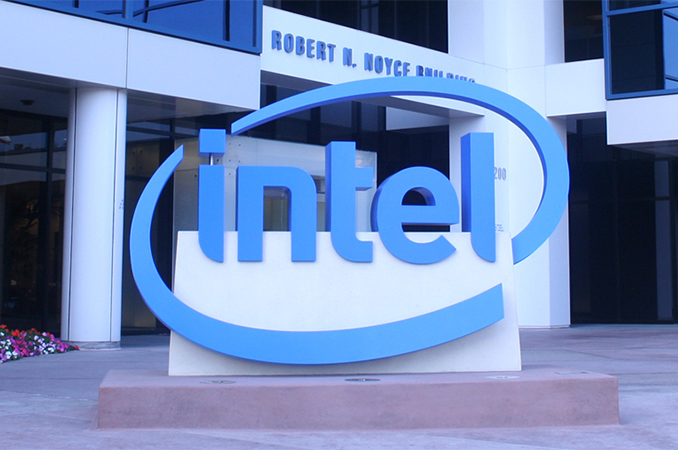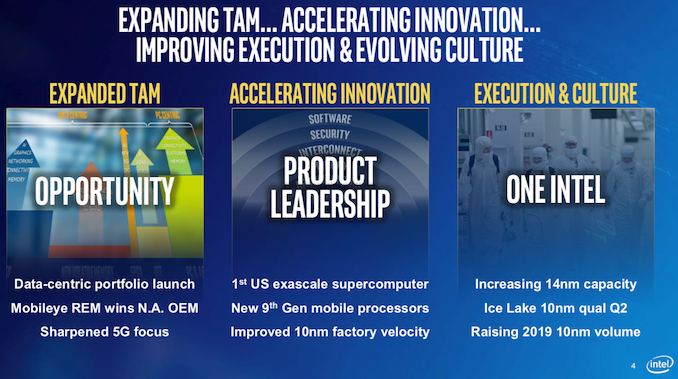Intel Starts Qualification of Ice Lake CPUs, Raises 10nm Volume Expectation for 2019
by Anton Shilov on April 25, 2019 5:14 PM EST
During its Q1 earnings call, Intel provided an update regarding its 10 nm process technology as well as the ramp up of its Ice Lake-U processor for notebooks, which is the company’s first 10 nm design that will be mass produced and broadly available. Qualification for the new processors has already started, so systems based on Ice Lake-U will be available by the holidays, as promised. Furthermore, Intel believes that it will be able to ship more 10 nm parts than it originally anticipated.
Ice Lake-U in 2019
Intel started production of its Ice Lake-U processors in Q1, but Intel has been building up a stockpile of them first before they are sent to PC makers for qualification. Once the CPUs are qualified — something that Intel expects to happen in Q2 — the manufacturer can start sales/shipments of these CPUs, which will likely happen in Q3. Considering the lead-time required to get built systems on to store shelves, Ice Lake-U-based PCs are on track to hit the market in Q4 (something Intel reaffirmed today).
Intel’s Ice Lake-U is a quad-core processor based on the codenamed Sunny Cove microarchitecture. Among other notable features, on the CPU side of matters Ice Lake-U supports VNNI and Cryptographic ISA instructions, as well as Intel's long, long awaited support for LPDDR4X memory. Meanwhile on the GPU side of matters, this is the first chip to integrate Intel’s Gen11 iGPU, which with up to 64 execution units, promises a big step up in performance. The CPU will be paired with a chipset natively supporting Thunderbolt 3, 802.11ax Wi-Fi, and a number of other innovations. The whole Ice Lake-U package is expected to have a TDP of 15 W, so the product will be able to address thin-and-light and mainstream laptops.
10 nm Volume Goals Increased
It is noteworthy that Intel now expects to ship more processors made using its 10 nm process technology than originally anticipated this year as it can produce more these CPUs.
“On the [10 nm] process technology front, our teams executed well in Q1 and our velocity is increasing,” said Bob Swan, CEO of Intel. “We remain on track to have volume client systems on shelves for the holiday selling season. And over the past four months, the organization drove a nearly 2X improvement in the rate at which 10nm products move through our factories.”
Ice-Lake-SP Xeons in 2020
As for 10 nm ramp in general, Intel is only talking about producing its relatively small Ice Lake-U processors in volumes this year, which is the company’s typical way of ramping up a new node. When it comes to their larger Ice Lake-SP server parts, Intel expects to launch those 10 nm Xeon products in 2020. The company says that its Ice Lake-SP CPUs will be available in less than 12 months after its Ice Lake-U products hit the market. In fact, Intel has even advised investors to expect 10 nm Xeons to arrive “rather sooner than later” in 2020, which would imply something earlier than Q4'2020.
Related Reading:
- CES 2019 Quick Bytes: Consumer 10nm is Coming with Intel’s Ice Lake
- Intel 10nm Production Update: Systems on Shelves For Holiday 2019
- Intel Delays Mass Production of 10nm CPUs to 2019
- Intel’s Xeon Scalable Roadmap Leaks: Cooper Lake-SP, Ice Lake-SP Due in 2020
- First 10nm Cannon Lake Laptop Spotted Online: Lenovo Ideapad 330 for $449
- Intel Discloses Plans to Spend $5 Billion on Fab 28 Expansion in Israel
- Intel's 10nm Briefly Appears: Dual Core Cannon Lake in Official Documents
- Intel Mentions 10nm, Briefly
- Intel Displays 10nm Wafer, Commits to 10nm ‘Falcon Mesa’ FPGAs
- Intel: EUV-Enabled 7nm Process Tech is on Track
Source: Intel











70 Comments
View All Comments
name99 - Thursday, April 25, 2019 - link
When has the SEC EVER held Intel to account.Compare
https://www.anandtech.com/show/7309/intel-14nm-pro...
Sept 2013 --- Broadwell is on track, ready for the end of the year
and
https://www.extremetech.com/computing/168799-intel...
Oct 2013 --- Oopsie, sorry we're delaying it one quarter.
BTW when did Broadwell ACTUALLY ship?
Oct 2014...
Still waiting for the SEC investigation into that. (Or the acknowledgement by Intel fans that there is a long term pattern of lying that didn't just start with 10nm.)
nevcairiel - Thursday, April 25, 2019 - link
Those "leaks" are based on enterprise timelines, which is slower to adopt new desktop CPUs, so even if those are true and still up to date, it may not necessarily say much about actual 10nm desktop parts being released in 2020.name99 - Thursday, April 25, 2019 - link
Whom to believe?Well, WTF does "our velocity is increasing" mean?
“On the [10 nm] process technology front, our teams executed well in Q1 and our velocity is increasing,”
I think I'd vote for the liar being the guy who chooses to say word salad...
flgt - Thursday, April 25, 2019 - link
I know it’s management speak but it’s positive management speak. The roadmaps were so conservative that he really didn’t need to say those things. He could have said we’re shipping a few parts and moved on. I take it as some recent good news.Spunjji - Friday, April 26, 2019 - link
There's no such thing as negative management speak, though - the entire point is to say nothing concrete while sounding positive. Your response is effectively to say "yeah but I want to feel good about this so I made up a reason". That's fine, but it's also completely illogical :)Rudde - Sunday, April 28, 2019 - link
He explained that their volume going through their factory has doubled in the recent four months. That is a 'velocity' increase.Bp_968 - Thursday, April 25, 2019 - link
The WCC article was rumor, this is a release by the company. This is much much better news in general. I am no more interested in seeing Intel nosedive than I am in seeing AMD nosedive. What is happening now is almost perfect, AMD is gobbling up a sizable chunk of traditionally intel product segments (server, enthusiast, etc) and hopefully gaining R&D budget to spend on GPUs to pressure Nvidia. The same goes for Intel. I want to see them succeed with their GPU and pressure Nvidia. Right now Intel is being forced to offer competitive products at more competitive prices. Nvidia now needs that same pressure. Right now in almost all market segments Nvidias only competitor is Nvidia. Thats bad for innovation and bad for customers.Dragonstongue - Thursday, April 25, 2019 - link
Radeons have only need to "optimize" just like Nv has done since the 600 series, AMD "more or less" have not been ABLE to do such in all honesty, now they are able, if something like an RX680 with optimizations became eventually the GTX 1080, titans and such, AMD did Vega and Radeon 7, but they are NOT "cut to the wick" to get them pure game grunt, Nv did exactly that and the "cost" was for some of the more advanced things that not everyone wants/needs to do anymore, such as "mining"if Nv could "tame a hot beast, such as RX 480/580/680 than AMD given the same flexibility can very very easily do this same thing, they have lots of experience and many generations to back it up, 4870 "base example, became the 7870 by far one of the best gpu released for the price, power, temps etc.
Anyways, this is a very very rare occurrence for AMD, last time this happened was Athlon days, but, they could not keep up with demand THEN (even if Intel did nothing) unlike now where they can push tends of millions product per quarter when "fully ramped up", seems w/e problems Intel was.is having AMD has been able to dodge such since Ryzen release, and with GPU wise, they can see what they must face, Nv did a slight stumble, if AMD does not do such a stumble with Navi, then likely will be a repeat of 4870 vs 280 days, 280 for more grunt but that much hotter etc or 4870 for near the same play but less cost and power etc.
it can happen, it did for other companies and these days AMD has a massive amount of raw talent with tons of manufacturing space unlike a decade or so back ^.^
drunkenmaster - Thursday, April 25, 2019 - link
Intel have been lying a ridiculous amount about their nodes through the past, well 6 years ago now is when 14nm was supposed to be a year away and on track, then every quarter it got pushed back another quarter, then it finally launched a year late. Throughout that delay they said 10nm had zero issues, was on track and the delays at 14nm don't effect 10nm at all. Then throughout the 4 years since 14nm launched and the 3 or so years since the originally planned 10nm launch they've lied about how ready it is. They were lying right up to the quarter before they launched that 10nm chip that ended up in two products in tiny volume then officially delayed the node an extra 18 months. Yields don't change overnight, they had to know pretty much latest mid 2017 that there was absolutely no chance for desktop or server chips in 2018 but they lied up to and including with the launch.Intel is not a better source of news in general, they've proven themselves to have effectively no credibility on news on their nodes at all. Until what they start saying is matched by actual events in the real world over a period of time such that they re-establish their credibility, then realise that these are messages to keep the stock prices going because that is their only real goal.
They can get around SEC lawsuits by both keeping the share prices high as they have done through the last 3 years, and by fudging the truth. Hey at that time we totally thought it was on track, but 3 months out from launch when we delayed by another quarter, then again, then again, that was new information.
I personally do want Intel to nosedive, they need less power, we need more AMD marketshare so they have a future and Intel have so much money and influence right now even with Zen being very good AMD's future is still precarious. We could do with a few bad years to level the playing field and let both companies survive long term without either one completely dominating the market and being able to use undue influence to prevent the other succeeding.
name99 - Thursday, April 25, 2019 - link
"'Throughout that delay they said 10nm had zero issues, was on track and the delays at 14nm don't effect 10nm at all."On the positive side, 7nm is totally on track and the delays at 10nm don't affect 7nm at all :-)